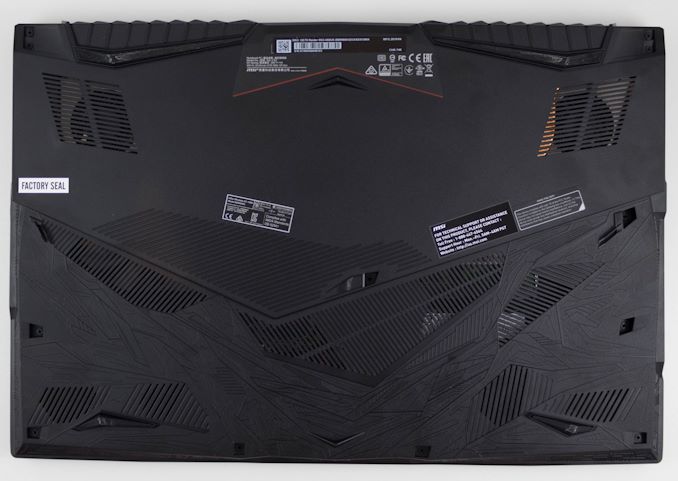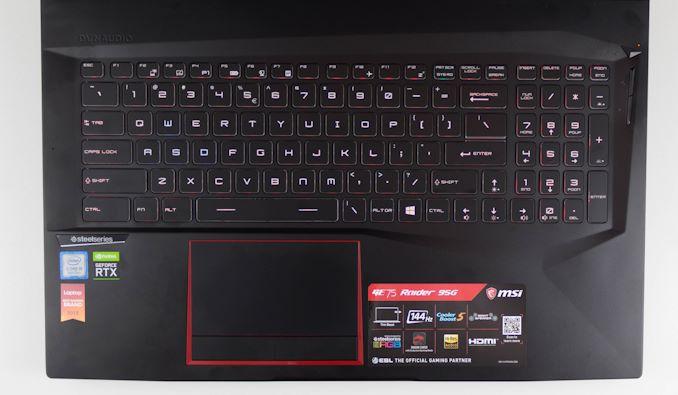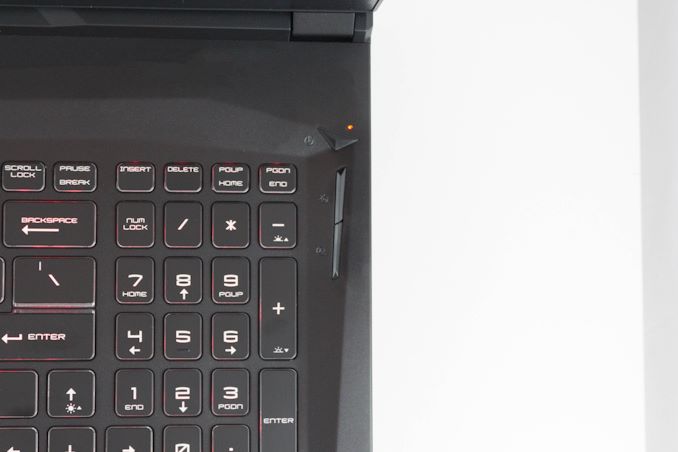The MSI GE75 Raider Laptop Review: Core i9 and RTX 2080 Performance
by Brett Howse on July 12, 2019 8:00 AM ESTDesign
MSI has created a cohesive design language that they’ve been using across their lineup for some time now, and they’ve been tweaking it with each generation. The GE75 Raider is unmistakably an MSI gaming laptop though, featuring the familiar black aluminum lid, light-up dragon logo, and red accents. Although theming is a personal thing, MSI does a great job of adding accents and touches without getting out of hand.
The entire chassis isn’t aluminum, but MSI’s use of plastic on the underside doesn’t detract from the feel of the laptop, especially considering as a 17-inch gaming laptop it’s going to be sitting on a desk most of the time. The plastic is also one of the few areas where MSI added a lot of “gamer” design with what MSI describes as “to show the spirit of cosmological warship as the asymmetry shape” and although that meaning isn’t exactly clear, this design is only on the bottom and therefore not something that would normally detract from the device if you aren’t into the outlandish design statements.
Opening the lid we see that MSI offers a thin-bezel design in their large form factor laptop, making the GE75 Raider significantly smaller than a 17.3-inch laptop from just a couple of years ago. The form factor is still larger than a 15.6-inch, but with the reduction in bezel size and therefore overall width of the laptop, it doesn’t feel much larger than many 15.6-inch models, despite the larger display.
But it is of course a bit bigger, and looking at the keyboard makes this obvious, since MSI was able to fit in a number pad on the right without the same sacrifices you’d see on a typical 15.6-inch model. Although the number pad isn’t as full-sized as a desktop keyboard, other than the half-width zero key it is otherwise identical in layout and is a useful addition when there’s enough room on the deck.
The keyboard itself is a treat as well, and once again MSI has added in a SteelSeries keyboard with per-key RGB backlighting. Much of their competition still uses zoned backlighting, which is not even in the same realm as the quality of this RGB backlight. The colors are strong and provide plenty of adjustable lighting through the keys, and although the tendency of RGB everything can be seen as an addon with limited value, per-key RGB backlighting does in fact offer benefits that you’d not be able to achieve with a zoned backlighting system. For instance, I use the Prt Scn button often, but the location on a laptop keyboard can vary, so you can easily set this one key to a unique color and always be able to find it in a second. The typical WSAD key colors can also be changed, and one excellent feature MSI does is that it blacks out all of the keys except those with a function assigned when you press the Fn key, making it simple to find the right key to change the volume, or adjust the brightness.
The feel of the keyboard is good, with nice travel and weight. But despite being a quality keyboard, there are a few issues. First, the key caps are slightly convex, so your fingers can tend to slide around on them, and it is a strange feeling. The best keyboards tend to have concave key caps, providing a solid spot for your finger to rest in. Second, this keyboard has a slightly strange layout, with the Windows Key being on the right side of the keyboard along with a duplicate backslash key. It’s something you would get used to, but as someone who jumps around on lots of devices, it feels strange.
Located to the right of the keyboard are some dedicated buttons as well. At the top is a power button, nicely located away from the keyboard, and below that is a button to toggle the backlighting modes, and finally below that is a button to adjust the fan profile.
Moving on to the trackpad and we have another win for MSI. The size is generous, but fits in well with the larger size of this laptop, and MSI has actual physical buttons at the bottom as well, which are appreciated for gaming. You’d still likely want a mouse for gaming, but the trackpad is smooth and responsive, and works well. The multi-touch gestures work flawlessly, and the physical buttons add options depending on your task.
There’s enough I/O as well, with two USB Type-A ports on the right side, along with an SD card slot and power connector, and on the left is another Type-A port, HDMI, mini DisplayPort, USB Type-C, Ethernet, and the two 3.5 mm audio jacks. It’s well-equipped although the Type-C port isn’t Thunderbolt 3, which is a bit of a strange omission, although it is a Gen 2 port.
Overall the design is excellent, and continues in MSI’s tradition of offering a very well-built laptop in the gaming space. The styling is pure MSI, but without being too over the top. The red accents work really well, and the keyboard is one of the better ones in its class. The GE75 Raider is off to a great start.
















30 Comments
View All Comments
gunnys - Friday, July 12, 2019 - link
The current lack of 4K 17.3" gaming laptops is depressing. We have faster hardware but low res displays.DanNeely - Friday, July 12, 2019 - link
As noted in the article itself, MSI is currently limiting the 17" 4k option to their even higher end and chunkier GT76 series.gunnys - Friday, July 12, 2019 - link
I missed that, thanks for the heads up. But I also meant in general, lack of 4K sucks. I spend way more time not gaming than gaming, and would appreciate higher pixel density in general tasks. Personally I'd be more pleased with 4K at even just 60 Hz. A 120 Hz or 144 Hz panel would be useful just a few hours a month in gaming.And the whole situation makes even less sense when I'm seeing plenty of 15.6" 4K laptops.
I've heard the new Razer Blade Pro will only ship with 4K in it's upcoming Quadro RTX version. It appears manufacturers are reserving 4K for the highest tier only. In that case.... I'll hold off on buying. I don't need a Quadro or a $4000 laptop... just more pixel density. An RTX 2080 or Quadro isn't needed to drive Windows, Office, and Youtube at 2160p.
A decent 17.3" 4K panel wasn't a huge upgrade cost just a year or two ago.
DanNeely - Friday, July 12, 2019 - link
as an ever more niche product line 17" laptops tend to lag badly in any components (like screens) that can't be shared with more plebeian 15" laptops. Volumes of high end 13 laptops are higher than 15" and 15" is higher than 17"; with the result that most of the higher end screen options started at the smallest size where there was more volume to be sold and then worked their way to smaller volume parts only slowly.When I get my next laptop in a year or two I'm hoping to be able to find something with 1440p/144hz at 15". 4k's massive overkill, drives up power consumption. 1440p is good enough for general use and is at least somewhat plausible to game at above 60hz on the occasions I do that instead of just surfing the web.
quiksilvr - Friday, July 12, 2019 - link
I would say not having G-SYNC is the bigger issue.tshoobs - Wednesday, July 17, 2019 - link
I agree that it is sad to still see so many gaming laptops in this class using 1080p - that is really not enough pixel density for a 17.3" screen.For general use, 4k resolution in this screen size still generates a lot of need for scaling which in Windows is as good as it has ever been but still flawed.
I'd love to see a 1440p panel however, I think that would be perfect for the 17.3" gaming laptop. 1080p is very long in the tooth.
ingwe - Friday, July 12, 2019 - link
Given that it is a 144 Hz IPS display with great color accuracy, I think it is still a display to be happy with.weilin - Friday, July 12, 2019 - link
I'd personally prefer QHD (2560x1440) over UHD. Especially for screens smaller than 24". It seems like the best compromise on resolution and performance.quantumshadow44 - Friday, July 12, 2019 - link
Im perfectly fine with 4k on 15" dell m4800.100% srgb/Adobergb
pbollwerk - Friday, July 12, 2019 - link
My current laptop (Alienware 13) has the "near"-4k OLED, and while it looks gorgeous, I don't like the performance hit I get when gaming, and text is unreadable. Maybe 4k is better on a 17", but my next gaming laptop won't be 4k. For gaming, it's not worth it for me.For other tasks, like video/photo editing, I can understand. But this is a gaming laptop.
Having said that, 1080 is too low resolution for modern laptops.